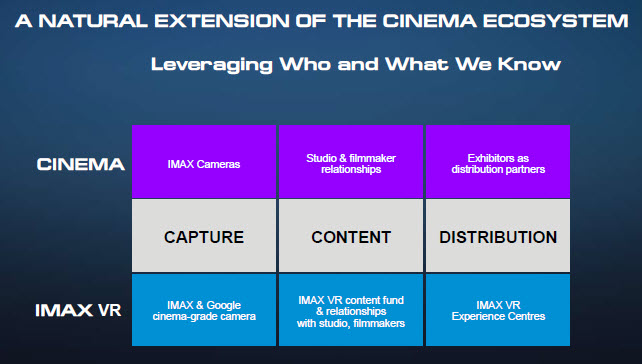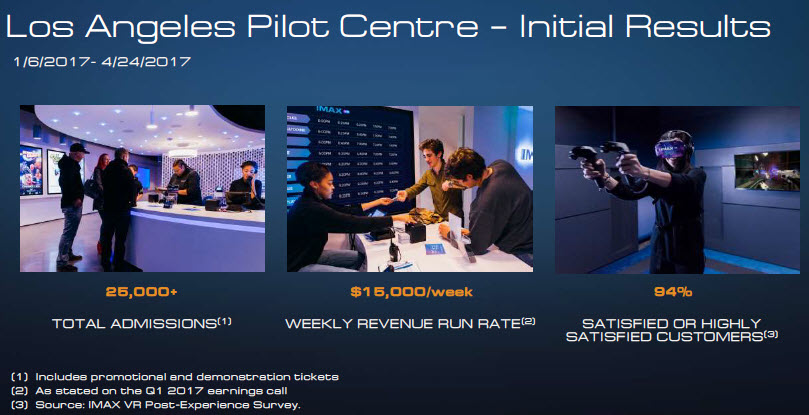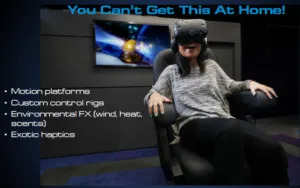The final speaker for the day at the Investor’s Conference was Amit Shalev, Head of VR Technology & Design at IMax Corp.
She said she would talk about other ‘paths to success’ for VR. VR is not meeting expectations, say the press, but success comes in many colours.
- Technology is continually evolving through academic, aviation and medical applications and now into entertainment
- Businesses have developed based on VR alone.
- There is increased awareness of VR
- There has been a lot of development of content toolkits and standards
- etc etc
However, there has not been mass adoption by consumers, yet. That could mean different things to different people. The market needs, perhaps, some acceptance that the technology is important for consumers’ lives. Cheaper, better, lighter, stylish is necessary for the growth of the market, Shalev said, but not sufficient. There needs to be a killer app and that needs the right technology.
The longer the industry continues, the sooner the killer app will appear and that will mean that there won’t be just a single investment opportunity window. Just because last year wasn’t great, that doesn’t mean VR won’t happen in the future.
To say VR is a failure is not true – sometimes there are slow downs because of short attention spans, news cycles and hype cycles. There is also a shallow understanding of the VR ecosystem. Unrealistic expectations are created by this combination that causes a perception of failure.
There was an article in Variety saying that VR is a fad – like 3D TV. Shalev said that “it’s not a sprint or a marathon, it’s a relay”. One thing enables another. An important point for the development of the market is coming up with new business models. A model that makes some money now may be enough to keep things moving along. Where are the killer verticals?
- Connection/Communication/social
- Entertainment
- Education
- Enterprise
- Health & Wellness
- Etc
Some people use the term VR to mean a technology or a platform or an experience. However it may really a completely new medium of communication or creative expression.
Hollywood may have a new movie that will also be a game on an XBox and may ‘also be on VR’. They really mean that it is just an immersive title. You can make an immersive experience by just storytelling, so that’s not it. Shalev believes.
VR Must be a Medium
To get to public mass adoption, VR must be a medium. The medium has to be unique that can’t be got anywhere else. If you forget your reality and its unique. it may still not be unique. That may be doable with another medium. So VR has deliver a completely unique experience.
It’s not a game, but an experience in VR and neither is just a movie you can walk through. What is the experience first? It’s not a game first, it’s not a story first. If I don’t understand what the experience should be, I can’t develop the medium, Shalev said.
She then turned to Location-based VR. This reduces the barrier to entry for high quality VR as the consumer doesn’t have to spend a lot of money in a set-up.
IMax is trying to develop a high quality experience that has ‘reduced friction’ and in an ideal world people would simply “float off the street” into a VR experience without any other obstacles. You need to make people comfortable so its about more than simply the technology. The spaces used should make people feel at home and much that IMax has done has been based on the design of theatres as people already understand these locations.

Shelav’s employer has a lot of relationships in content, capture and distribution and so the company wanted to use the relationships in these areas. The firm is developing a high end camera, for example. It is developing both stand-alone and cinema-based centres for VR.
IMax wants to take the best technology and content and combine that with the best platform to try to create a compelling experience. The firm has set up a $15 million investment fund to encourage content creation. The company already has several experiences including Star Wars and ‘The Walk’ and ‘John Wick’ and it is also looking at “Eagle Flight” from UbiSoft.
IMax is curating content and working with companies on technology and is collaborating with Acer and Starbreeze on a VR headset. Motion platforms and environmental effects may also be part of the solution in the future especially as these are harder to include at home.
At the moment, social VR is not really realistic as each user has to make a big investment in equipment. Reducing the capital expenditure is another thing that reduces the friction to trying VR for event-based operators. Hygiene, however, can be an issue and safety could be a problem – you don’t want users to fall off their high heels. What is appropriate content for different ages? If the experience is very intense and content is very stressful, that could also be a problem for some guests.
As a user, you also may have to deal with a legal waiver and IMax has worked to try to make this as simple as possible.
Centres are Open
The first IMax centre opened in Los Angeles in January and the econd one will open in a cinema in New York. Most of the guests that have visited in LA have not tried VR before. Shalev said that guest sales have been good with good revenues. Another 10 centres are to be piloted globally in 2017.
Things that IMax has learned include:
- VR has potential today.
- You have to learn the friction points.
- Not every “bell and whistle” adds value
- You need to learn to curate content to make compelling experiences
- You may need to take content to make it useful for Location-based-VR
IMax is working with studios to get more optimised content for its locations.

Through the tests and pilots, it is hoped to develop what you need to do to build a “killer app” for consumer VR. However, the project may be a success even without this. Shalev believes that VR will change people and humanity for the long term.
Pricing at IMax averages at about $1 per minute depending on the content. There are levels of ticketing – sampling with a number of smaller experiences costing $20 – $25, features at $10 – $12 and cheaper experiences are $7.
The company is getting above 45% of consumers returning for another experience. Many visitos try multiple experiences – 2.X at a time is typical. 40% of guests say they want to come back and bring friends.

